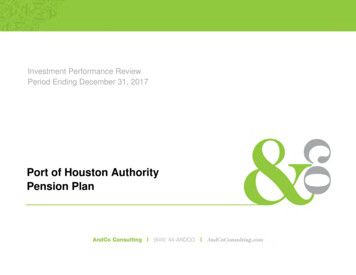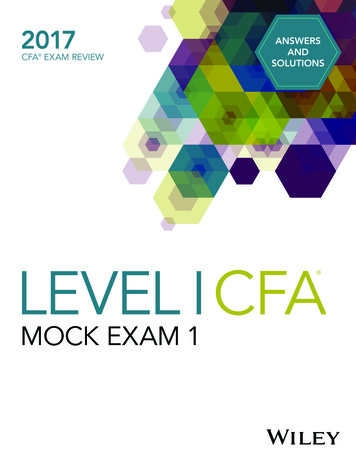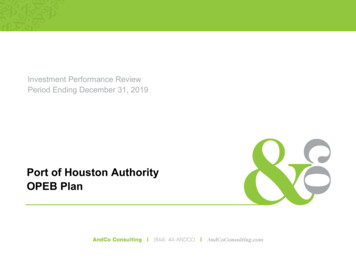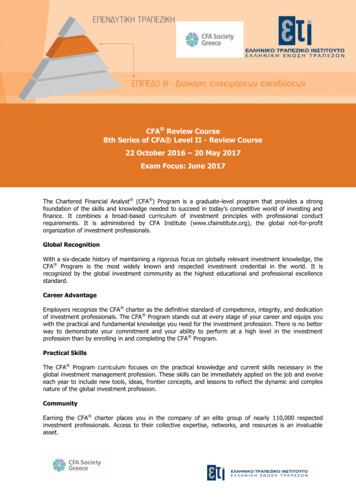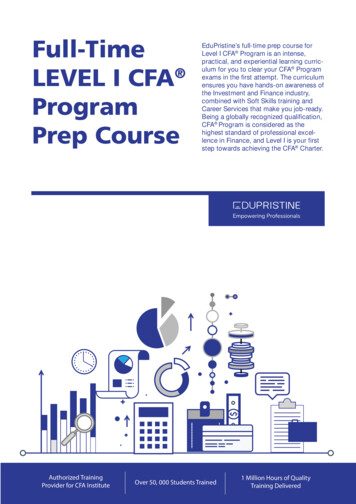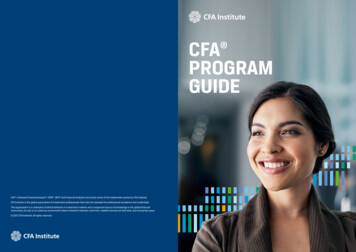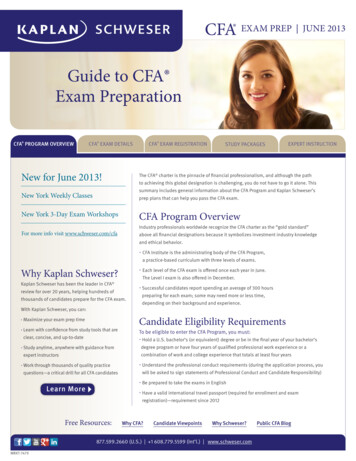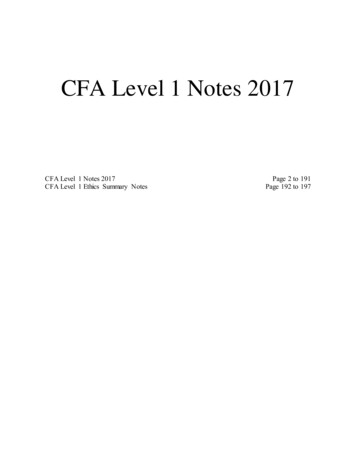
Transcription
CFA Level 1 Notes 2017CFA Level 1 Notes 2017CFA Level 1 Ethics Summary NotesPage 2 to 191Page 192 to 197
Ethical conduct improves outcomes for stakeholders, by balancing self interest with impacton othersCode of ethics rules and standards that require minimum level of ethical behaviourProfessional code of ethics way for profession to communicate to public that its memberswill use knowledge/skill to serve clients in honest and ethical manner à increase publicconfidence and trust that members will act ethicallyChallenges to ethical behaviour: Overestimating own ethical character à overconfidence bias Considering only near term consequences Letting situational (external) influences such as peer pressure, loyalty unduly affectdecisions and behaviouro Overate ethical quality of own behaviour and overemphasize importance ofown personal traits à situational influences are more important thanpersonal/internalUnethical behaviour (such as providing misleading info) could affect allocation of capitalraised à negative consequences on all stakeholders in economyEthical principles often set higher standard of behaviour than laws and regulations. Newlaws result from instances of unethical behaviour (e.g. Securities Act 1933, Glass-Stegal Act,Securities Act 1934, Sarbanes-Oxley laws (Enron and Worldcom), Dodd-Frank Act (GFC).Ethical decisions require more judgment and consideration of impact of behaviour onstakeholders than legal.Ethical decision making framework: Identify: facts, stakeholders, duties, ethical principles, conflicts of interest Consider: situational influences, additional guidance (e.g. friends, compliancedepartment), alternative actions (short and long term effects) Decide and act Reflect: evaluate outcomes of actions - was outcome as anticipated?CFA Institute Professional Conduct Program (PCP) PCP in conjunction with DRC are responsible for enforcement of the Code andStandards Covered by CFA Institute Bylaws and Rules of Procedure for Proceeding Related toProfessional Conduct Based on principles of fairness of process to members and maintainingconfidentiality of proceedings All CFA members and candidates enrolled in CFA are required to comply with codeand standards Disciplinary Review Committee (DRC) has responsibility for program andenforcement of Code and Standards volunteer committee INQUIRY: CFA Institute Professional Conduct staff conducts inquires related toprofessional conduct à can be prompted by 4 things:o Self-disclosure by members on Professional Conduct Statements ofinvolvement in civil litigation or criminal investigationo Written complains to PCP about member’s conducto Evidence of misconduct my member received through public sourceso Report by CFA exam proctor of possible violationo Analysis of exam material and monitoring social media by CFA Institute INVESTIGATION: Once inquiry begins, staff may request (in writing) explanationfrom member and may interview the member, interview complainant/3 d party andcollect documents/records relevant to investigation
oooNo disciplinary sanctions appropriateIssue cautionary letterDiscipline member à member must accept or reject sanction. If rejected,matter referred to DRC of Members.§ Sanctions include public censure, membership suspension,revocation of charter6 Code of ethics1. Act with integrity, competence, diligence and respect2. Place integrity of profession and clients above personal interests3. Reasonable care and exercise independent professional judgment when makinginvestment recommendations4. Practice and encourage others to practice in ethical manner5. Promote integrity and viability of global capital markets6. Maintain and improve professional competence7 standards of professional conduct1. PROFESSIONALISMA. Knowledge of the law (including code of ethics and standards of professionalconduct) in the event of a conflict, the stricter law, rule or regulationapplies.B. Independence and objectivity not offer or accept gift or compensation thatwould compromise independence/objectivityC. Misrepresentation analysis, recommendations or actions§ Crediting source not required when using statistics, tables andprojections from recognised financial and statistical reportingservicesD. Misconduct not engage in conduct involving dishonesty, fraud, deceit2. INTEGRITY OF CAPITAL MARKETSA. Material nonpublic info that could affect value of investment§ Public once it is announced to the marketplace§ Mosaic theory reaching investment conclusion through analysis ofpublic info non-material nonpublic info§ Members should make effort to achieve public dissemination by thefirm of information they possess. Firms should review employeetrades and maintain watch lists.B. Market manipulation not distort prices or artificially inflate trading volumeà only if there is INTENT to mislead.3. DUTIES TO CLIENTSA. Loyalty, Prudence and Care act in benefit of client, place clients interestbefore employer’s/own interest§ Submit at least quarterly statements showing securities in custodyand all debits, credit and transactions. Not vote on all proxies.B. Fair Dealing dealing with clients when making analysis, recommendations,engagement§ E.g. do not take shares of an oversubscribe IPOC. Suitability risk and return objectives, suitable investments, consistent withobjectives and constraints of portfolio§ Members gather info at beginning of relationship in the form of aninvestment policy statement (IPS)§ If trade has material impact, you can update IPS so client acceptschanged risk profile that would permit the trade. If client wont
accept the changed IPS, manager may follow firm policy which mayallow client-directed accountD. Performance presentation fair, accurate and complete§ Member must not state or imply ability to achieve rate of returnsimilar to that achieved in the past§ Member should present performance of weighted composite ofsimilar portfolios rather than single account§ Include terminated accounts and state when terminatedE. Preservation of confidentiality keep info about clients (current and past)confidential unless 3 exceptions: illegal activities, disclosure required by law,client permits disclosure4. DUTIES TO EMPLOYERSA. Loyalty act for benefit of employer and not divulge confidential info§ No requirement to put employer interests ahead of family andpersonal obligations§ When leaving an employer, member must continue to act untilresignation is effective§ Violations include misappropriation of trade secrets and client lists,misuse of confidential info, soliciting employer’s clients, self-dealing.B. Additional Compensation Arrangements not accept gifts, benefits thatmight create conflict of interest unless obtain written consent from allparties involved§ If client offers bonus depending on future performance, this is ancompensation arrangement à requires written consent in advance§ If client offers bonus depending on past performance, this is a giftà requires disclosure to employer to comply with Standard I(B)Independence and ObjectivityC. Responsibilities of Supervisors make sure people comply with laws,regulation and Code and Standards5. INVESTMENT ANALYSIS, RECOMMENDATIONS AND ACTIONSA. Diligence and Reasonable Basis reasonable basis supported by researchand investigation for analysis, recommendation§ Application depends on investment philosophy adhered to,members’ roles in investment decision making process, andresources and support provided by employer§ Considerations include economic conditions, firms financialresults/operating history, fees and historical results, limitations ofquant models, peer group comparisons for valuation areappropriate§ Members should encourage firm to adopt policy for periodicinternal review of quality of 3 d party researchB. Communication with Clients disclose basic principles of investment processand construct portfolios and any changes that might materially affectprocesses, significant limitations and risks, identifying important factors andcommunicate them, distinguish between fact and opinion.§ Expectations based on modeling/analysis are not facts§ Communicate gains/losses in terms of total returns§ Explain limitations of model/assumptions used and of theinvestment itself e.g. liquidity and capacityC. Record Retention develop and maintain records to support analysis andrecommendation with clients (e.g. documenting details of convo)
Member who changes firms must re-create analysis documentationsupporting recommendation and must not rely on material createdat previous firm§ If no regulatory standards/firm policies in place, recommends 7-yearminimum holding period6. CONFLICT OF INTERESTA. Disclosure of Conflicts matters that could impair independence andobjectivity or interfere with duty to clients and employer§ E.g. ownership of stock in company that recommending§ E.g. compensation/bonus/commissionsB. Priority of Transactions clients/employers priority over own§ Limitations on employee participation in equity IPO, privateplacement§ Blackout period no personal purchase/sale of security in advanceof client/employerC. Referral Fees compensation received or paid to others forrecommendation of products/services7. RESPONSIBLE AS A CFA INSTITUTE MEMBER/CANDIDATE1. Conduct as Participants in CFA Institute Programs not compromisereputation or integrity of CFA§ e.g. exam cheating, improperly using designation, not revealconfidential info regarding CFA, misrepresenting info onProfessional Conduct Statement (PCS)2. Reference to CFA Institute, Designation and Program not misrepresent orexaggerate meaning/implications§ Members must sign the PCS annually, and pay CFA membershipdues annually à if fail to do this, person will no longer be an activemember§READ STANDARDS OF PRACTICE HANDBOOK 11 EDITION 15% of questions based fromthis book and 2 short readings on GIPSINTRODUCTION TO THE GLOBAL INVESTMENT PERFORMANCESTANDARDS (GIPS)GIPS are a set of ethical principles based on standardised, industry-wide approach Investment firms can voluntarily follow GIPS in presentation of historical results toclients à Standards seek to avoid misrepresentation of performance Only inv mgmt firms that actually manage assets can claim compliance Created to make it easier to compare different investment management firms àGIPS allow clients to more easily compare performanceA composite is an aggregation of one or more individual discretionary portfoliosrepresenting a similar investment strategy or objective e.g. large cap growth stocks. Reporting on composites gives clients info about firm’s success in managing varioustypes of securities or results for various investment styles Must include all actual fee paying discretionary portfolios (past and present)o Actual no dummy portfolio. Fee paying no charity. Discretionary control over stock selection
Firm should identify composite before performance is known à prevents firm fromchoosing to include composite in order to create composite with superior returnso Must be determined on ex-ante basis (i.e. before period which composite’sperformance will be calculated) à pre-established criteriaOnce firm claims GIPS compliance, they must voluntarily hire a 3rd party to performverification Verification of GIPS compliance is optional, but if issued by 3 d party then reportmust be issued with respect to whole firm (firm-wide basis) Must attest 2 things:o Whether firm has complied with all composite construction requirementso Firms processes and procedures are established to present performanceaccording with calculation methodology, data requirements and formatrequired by GIPSGIPS Objectives à Goals of the GIPS Executive Committee: Obtain global acceptance of calculation and presentation standards in fair,comparable format with full disclosure Ensure consistent, accurate performance data in areas of reporting, records,marketing and presentations Promote fair competition among inv mgmt firms in all markets without unnecessaryentry barriers for new firms Promote global “self regulation”Key Characteristics of GIPS To claim compliance, firms must define its “firm” à reflect the distinct businessentity that is held out to clients and prospects as the firm Ethical standards for performance presentation which ensure fair representation Include all actual fee-paying, discretionary portfolios in composites for min 5 yearsor since firm/composite inception.o After 5 years of compliant data, firm must add annual performance eachyear going forward up to min 10 years. Firms required to use certain calculation and presentation standards and makespecific disclosures GIPS contain both required and recommended provisions à firms encouraged toadopt recommended provisions Encouraged to present all pertinent additional and supplemental info Follow local laws when in conflict with GIPS, but disclose the conflict Supplemental private equity and real estate provisions contained in GIPS are to beapplied to those asset classesDefinition of the firmRequirement Apply GIPS on firm-wide basis Firm defined as distinct business unit Total firm assets include total mkt value ofdiscretionary and non-discretionary assets,including fee-paying and non-fee-payingaccounts Include asset performance of sub-advisors,as long as firm has discretion over subadvisor selectionRecommendation Includebroadestdefinition of thefirm, includingall geographicalofficesmarketed undersame brandname
Document policiesand proceduresClaim of compliance Firm fundamentalresponsibilities If firm changes its organisation, historicalcomposite results cannot be changedDocument, in writing, policies andprocedures firm uses to comply with GIPSCompliance statement “ABC has prepared in compliance with GIPS”No such thing as partial complianceNo statements referring to calculationused in composite presentation orperformance of individual client as being“in accordance with GIPS” (unlesscomplaint firm is reporting results directlyto client)Compliant presentation to all prospects(within previous 12 months)Composite list and description to allprospects that make a request. Listdiscontinued composites for min 5 yearsIf jointly marketing with another firm,clearly define firm separation ifnoncompliantFirm must present min 5 years compliant performance unless firm or composite has been inexistence less than 5 years à “since inception” must be presented. After initial compliant presentation, 1 year of compliant performance must be addedeach year to a required minimum history of 10 years. Firms may present periods of noncompliant performance as long as nononcompliant performance if presented for any period after 1s January 2000Firms that previously presented performance in compliance with particular Country Versionof GIPS (CVG) may claim GIPS compliance prior to 1 Jan 2006. Must continue to include data until min 10 years compliant performance presented Where country specific regulations conflict with GIPS, firms must follow countryspecific regulations but must also disclosure nature of conflict with GIPS9 major sections of the GIPS standards0. Fundamental of Complianceo Definition of firm§ Distinct business entity held to clients claiming GIPS compliance§ Total firm assets fair value of all assets including discretionary,nondiscretionary, fee-paying and non-fee-paying accountso Documentation of firm policies & procedures with respect to GIPScompliance§ E.g. make complete list of composites to any prospective client àlist must include current and any terminated composites within last5 yearso Complying with GIPS updateso Claiming compliance in appropriate manner§ Not claim partial compliance.§ Not state specific calculation is GIPS compliant
1.2.3.4.5.6.7.8.o Appropriate verification statement when 3 d party verifier is employedInput datao Consistent in order to establish full and comparable performanceCalculation methodologyo Uniformity required so results are comparableo Must not use estimated trading expensesComposite constructiono Meaningful, asset-weighted composite with performance based onperformance of 1 or more portfolio with same investment strategyDisclosureo E.g. claim of compliance, currency, fee schedule, benchmark description,composite creation datePresentation and reportingo Investment performance according to GIPS. Other firm-specific info notspecifically required by GIPS should be included when appropriateReal estateo Provisions apply to ALL real estate investment (land, buildings) regardless oflevel of control firm has over it, or whether asset is producing revenue orleverage involvedo REITS, Commercial mortgage backed securities (CMBS) and private debtinstruments are not considered real estate and must follow sections 0-5Private equityo PE Investments must be valued according to Private Equity ValuationsPrinciples unless investment is open-ended or evergreen fund à follow GIPSo Not publicly traded regardless of stage of business development (e.g.venture capital, ownership of previously public company, mezzaninefinancing, limited partnership shares, and fund-of-funds investmentsWrap fee/SMA portfolioo Section 0 to 5 are supplemented or replaced by requirements specific in thissectionTime Value of Money The value of the investment’s cash flows must be measured at some common pointin time à at end of investment horizon (FV) or beginning of investment horizon (PV)Interest rates are a measure of the TVM. Equilibrium interest rates are the required rate of return for a particular investment. Interest rates are the opportunity cost of current consumption Discount rate for calculating PV of future cash flows Real risk-free rate is a theoretical rate on a single-period loan when there is noexpectation of inflation à investors increase in purchasing power (after adjustingfor inflation)o T-bill rates are nominal risk-free rates because they contain an inflationpremiumo Nominal risk-free rate real risk-free rate expected inflation rateTypes of security risks:
Default risk risk that borrower will not make promised payments in timely mannerLiquidity risk risk of receiving less than fair value for investment if it must be soldfor cash quicklyMaturity risk long-term bonds are more volatile than short-term bonds and hencehave maturity risk requiring a maturity risk premiumEach risk factor is associated with risk premium that is added to nominal risk free rate toadjust for greater default risk, less liquidity and longer maturity relative to very liquid, shortterm, default risk free rate such as that on T-bills Required interest rate nominal risk free rate default risk premium liquiditypremium maturity risk premiumoNote: nom na r sk free rate rea r sk free rate nf at on prem umStated annual int rate – quoted int rate that does not account for compoundingEffective annual rate – annual rate of return earned after adjustments made for differentcompounding periods. The rate of interest that investor realizes as result of compounding. (i.e. 8% savings ratecompounded quarterly as supposed to 2% per quarter)m EAR (1 periodic rate) – 1o M number of compounding periods per yearo Periodic rate stated annual rate/m EAR increases at a decreasing rate as compounding frequency increases It is necessary when comparing investment that have different compounding periods àapples-to-apples rate comparison Continuous compounding – if number of compounding periods become infiniterno FVN PV(e )ro e - 1 EARFuture value amount which current deposit will grow over time when placed in accountpaying compound interest à compound value FV PV(1 I/Y)No PV money invested todayo I/Y rate of return per compounding periodo N total number of compounding periodso (1 I/Y)N referred to as future value factorPresent value – today’s value of a cash flow that is to be received at some point in thefuture à amount invested today at a given rate to end up with specific FV discounting future cash flows back to the present interest rate discount rate, opp cost, rate of return, cost of capital PV FV/(1 I/Y)No Known as present value factorAnnuity stream of equal cash flows that occur at equal intervals over a given period Ordinary annuity cash flows occurring at end of each compounding period Annuity date cash flows occurring at beginning of each compounding period𝐹𝑉 𝐴𝑛𝑛𝑢𝑖𝑡𝑦 𝑃𝑀𝑇𝑃𝑉 𝐴𝑛𝑛𝑢𝑖𝑡𝑦 𝑃𝑀𝑇1 𝑟 1 1𝑟1 1 𝑟𝑟31
Annuity due à 1 less discounting period since 1s CF is at t 0 and hence already itsPVo PV Annuity Due PV Ordinary Annuity * (1 r)§ PV of annuity due PV ordinary annuityPerpetuity financial instrument that pays fixed amount of money at set intervals over aninfinite period of time. i.e. perpetual annuity (i.e. set of never-ending sequential cashflows) e.g. British Consol bonds or most preferred stock𝑃𝑉 𝑃𝑒𝑟𝑝𝑒𝑡𝑢𝑖𝑡𝑦 𝑃𝑀𝑇𝑟Increase in compounding frequency à increase effective int rate à increase FV à decreasePVLoan amortisation process of paying off a loan with a series of period loan payments,whereby a portion of outstanding loan is paid off, or amoritsed, with each payment.e.g. Amortisation schedule for 10k loan at 10% for 5 yearsPeriod Beg BalPMTInterestPrincipal(beg bal * int rate) (PMT interest)110,000 2637.9710001637.9728362.03 2637.97836.2031801.76736560.263 2637.97656.031981.9444578.32 2637.97457.832180.1452398.18 ��𝑜𝑚𝑝𝑜𝑢𝑛𝑑 𝐴𝑛𝑛𝑢𝑎𝑙 𝐺𝑟𝑜𝑤𝑡ℎ 𝑅𝑎𝑡𝑒 𝐶𝐴𝐺𝑅 𝑃𝑟𝑒𝑣𝑖𝑜𝑢𝑠End Bal(beg bal principal)8362.036560.2634578.322398.180B/D 1Cash flow additivity principle PV of any stream of cash flows equals sum of PV of the cashflowsDiscounted Cash Flow ApplicationsNet Present Value (NPV) of an investment project is the PV of expected cash inflowsassociated with project less PV of projects expected outflows, discounted at the appropriatecost of capitalInternal Rate of Return (IRR) – discount rate for which NPV of investment is 0 i.e. rate of return that equates the PV of an investment’s expected benefits (inflows) withthe PV of its costs (outflows) Gives you sense of return on project - ‘internal' because depends on investment CF Discount rate IRR ve NPV Discount rate IRR -ve NPV If Discount rate (i.e. hurdle rate) IRR à 0 NPVNPV Decision Rule if project has positive NPV, this amount goes to firm’s shareholders Accept projects with positive NPV à increase shareholder wealth
Reject projects with negative NPV à decrease shareholder wealthWhen 2 projects are mutually exclusive, project with higher positive NPV should beacceptedIRR decision rule provides analyst with analysing an investment result in terms of rate ofreturn. IRR uses cost of capital as the hurdle rateà is the return of the project higher thanthe cost of capital? Accept projects with IRR firm’s required rate of return Reject projects with IRR firm’s required rate of returnIRR and NPV rules give same accept/reject decision when projects are independent If mutually exclusive (i.e. conflict) à use which one gives higher NPVHolding period return (HPR) - % change of value of an investment over the period it is held𝑒𝑛𝑑𝑖𝑛𝑔 𝑣𝑎𝑙𝑢𝑒 𝐶𝐹 𝑟𝑒𝑐𝑒𝑖𝑣𝑒𝑑𝐻𝑃𝑅 1𝑏𝑒𝑔𝑖𝑛𝑛𝑖𝑛𝑔 𝑣𝑎𝑙𝑢𝑒2 types of portfolio return measurement tools:1. Money Weighted Return ( IRR) - internal rate of return on a portfolio taking intoaccount all cash inflows and outflows à PV f ows PVou f owso Inflows beginning value of account and all deposits into accounto Outflows ending value and all withdrawalso Returns depends on timing and amount of CF.o Appropriate if PM has control of timing and amount of investment2. Time Weighted Return à measures compound rate of growth of 1 initiallyinvested in the portfolio a specified performance horizono Process of averaging a set of values overtimeo Preferred method of performance because it is not affected by the timing ofcash inflows and outflowso If funds contributed to portfolio at favourable time à moneyweighted return time-weighted rate of return§ Time weighted removes this distortiono Returns do not depend on timing and amount of cash flow.o Appropriate if PM does not control timing and amount of investmento[(1 rt1) (1 rt2) (1 rtn)] -1Annualized Time weighted return [(1 HPR )(1 HPR2)] /-1N number of per ods à only do 1/n if annualisedMoney market is the market for short-term debt instruments. T-bills (Treasury Bills) are pure discount instruments and quoted on a bank discountbasis5 different yield measures Bank Discount Yield, Holding Period Yield, Money Market Yield,Effective Annual Yield, Bond Equivalent Yield.Bank Discount Yield (BDY) expresses the dollar amount from the face value as a fraction offace value, not the market price. Annualizes using simple interest and ignores effects of compound interest Based on 360-day year rather than 365
𝐵𝐷𝑌 D scou𝐹𝑎𝑐𝑒 𝑉𝑎𝑙𝑢𝑒 𝑝𝑢𝑟𝑐ℎ𝑎𝑠𝑒 𝑝𝑟𝑖𝑐𝑒360 𝐹𝑎𝑐𝑒 𝑉𝑎𝑙𝑢𝑒𝑑𝑎𝑦𝑠 𝑡𝑖𝑙𝑙 𝑚𝑎𝑡𝑢𝑟𝑖𝑡𝑦 Vu c aseceHolding Period Yield (HPY) total return an investor earns between purchase date and thesale or maturity date (i.e. return for holding security of a period) Aka holding period return à actual return investor receives if held to maturity𝐻𝑃𝑌 𝑝𝑟𝑖𝑐𝑒 𝑎𝑡 𝑚𝑎𝑡𝑢𝑟𝑖𝑡𝑦 𝑖𝑛𝑖𝑡𝑖𝑎𝑙 𝑖𝑛𝑡𝑒𝑟𝑒𝑠𝑡 ��𝑙 𝑣𝑎𝑙𝑢𝑒Effective Annual Yield (1 HPY)365/ 1 Annualized HPY on basis of 365 days incorporating effects of compoundingMoney market yield (aka CD equivalent yield) is the annualized HPY, assuming a 360 dayyear à makes yield on T-bill comparable to yield quotes for interest-bearing money marketinstruments that pay interest on a 360 day basiso Annualized yield based on price of 360 day year that does not account forcompounding à assumes simple interesto MMY BDY𝑀𝑀𝑌 𝐻𝑃𝑌 𝑟QQ 360# 𝑑𝑎𝑦𝑠 𝑡𝑜 𝑚𝑎𝑡𝑢𝑟𝑖𝑡𝑦360 𝑟RS360 (𝑡 𝑟RS )Bond equivalent yield refers to 2 x the semi annual yield 2 * [(1 yield on annual bond)0 5) -1] Used because Bonds pay coupons semi annually Note: EAY BEYStatistical Concepts and Market ReturnsCentral tendency - Provide an indication of investment’s expected return Arithmetic mean, geometric mean, weighted mean, median and mode.Dispersion – indicate the riskiness of an investment Range, absolute deviation, varianceLack of symmetry (skewness) and which distribution is peaked (kurtosis)Descriptive statistics summarise important characteristics of large dataInferential statistics procedures to make forecasts, estimates and judgments about a largeset of data on basis of statistical characteristics of a smaller set (sample)Population set of all possible members of a stated group.Sample subset of the population of interest4 types of measurement scales
Nominal scales data put into categories that have no particular order à onlynames used (e.g. bond 1, bond 2 etc )Ordinal scales data put into categories that can be ordered with respect to somecharacteristics (e.g. ranking 1000 small cap growth stocks by performance)Interval scales provides relative ranking plus the assurance that differencesbetween scale values are equal (e.g. temperature degrees)Ratio scales provides ranking and equal differences between scale values and alsoa true zero point as the origin (e.g. measure of money in )o Absolute zeroParameter measure used to describe characteristic of a population (e.g. mean return andSD of returnSample statistic measure a characteristic of a sampleFrequency distribution summarise data by assigning specific groups or intervals and maybe measured using any type of measurement scale Absolute frequency actual number of observations that fall within an interval Modal interval interval with the greatest frequency𝑅𝑒𝑙𝑎𝑡𝑖𝑣𝑒 ��𝑙𝑢𝑡𝑒 𝑓𝑟𝑒𝑞𝑢𝑒𝑛𝑐𝑦 𝑜𝑓 𝑒𝑎𝑐ℎ 𝑟𝑒𝑡𝑢𝑟𝑛 ��𝑟 𝑜𝑓 stogram presentation of absolute frequency distribution Allows us to quickly see where observations are concentratedArithmetic mean is the only measure of central tendency for which sum of deviations fromthe mean is 0 à arithmetic mean sum of observations/# observations Used to estimate avg return over 1-period time horizonWeighted mean recognises different observations may have disproportionate influence ofthe mean. Return of portfolio is weighted average of returns of individual assets in the portfolioMedian may be a better measure of central tendency because it is not affected by extremevaluesUnimodal – when distribution has 1 value that appears more frequentlyGeometric mean – used when calculating avg investment returns over multiple periods or whenmeasuring compound growth rates𝑅Y[ 1 𝑅B 1 𝑅[ 1 𝑅D B/D 1 Geometric mean always less or equal to arithmetic mean à difference increases asdispersion of observation increases Since annual returns are compounded each period, GM is appropriate measure of pastperformance à gives average annual compound growtho GM best to estimate multi-year returnsHarmonic mean – can be used to find average purchase price𝐻𝑎𝑟𝑚𝑜𝑛𝑖𝑐 𝑚𝑒𝑎𝑛𝑁111 𝑥 𝑥[ 𝑥DIf returns are variable à Arithmetic mean Geometric Mean Harmonic Mean
Basis for claimed benefit of dollar cost averagingIf constant, AM GM HMThe greater the variability à the more AM will exceed GMQuantile value at or below which a stated proportion of data in a distribution line Quartile (quarters), Quintile (5ths), Decile (10ths), Percentile (hundredths) Quantiles and measure of central tendency measure of location 𝐿 (𝑛 1)Baan observation y percentileDispersion – variability around the central tendencyMean absolute deviation (MAD) – avg of absolute values of deviations of individual observationsfrom arithmetic mean𝑀𝐴𝐷 D dB 𝑋 Standard deviation MADStandard deviation 𝑚𝑒𝑎𝑛 𝑛 (return – mean)2Chebyshev’s inequality – % of observations that lie within k standard deviations ofthe mean is at least 1 – 1/k2 for all k 1 Basis for normal distribution (i.e. 75% of observations lie within / 2 SD’sfrom mean) Used to measure max amount of dispersion regardless of distribution shapeCoefficient of variation (CV) amount of dispersion in a distribution relative to it’s meanàrelative dispersion𝑆𝐷 𝑥𝐶𝑜𝑒𝑓𝑓𝑖𝑐𝑖𝑒𝑛𝑡 𝑜𝑓 𝑉𝑎𝑟𝑖𝑎𝑡𝑖𝑜𝑛 𝐴𝑣𝑔 𝑥 Enables us to make direct comparison of
CFA Level 1 Ethics Summary Notes Page 192 to 197. Ethical conduct improves outcomes for stakeholders, by balancing self interest with impact on others Code of ethics rules and standards that require minimum level of ethical behaviour Professional code of ethics way for profession to communicate to public that its members

